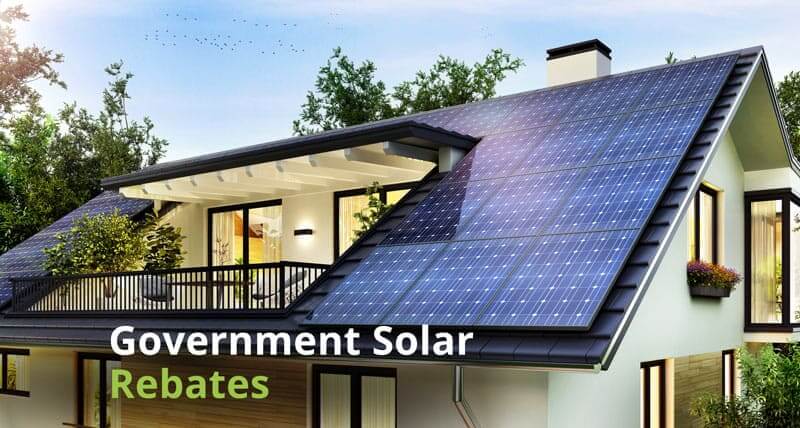Home Studies Best Australian State to go Off-Grid
Best Australian State to go Off-Grid in 2023
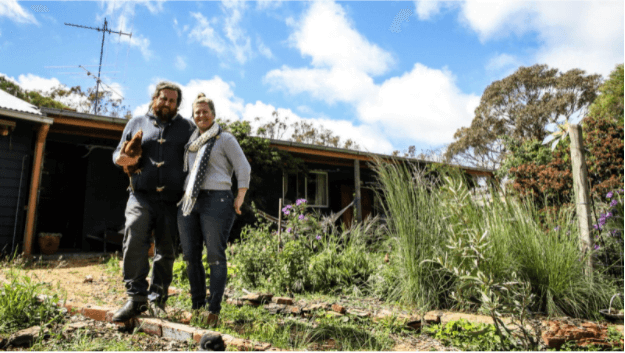
Craving a break from the city’s hustle or tempted by the charm of a rural retreat? Considering a leap into off-the-grid living? Choosing where to plant your roots in Australia could be the game changer for your budget and, in the long run, your success.
The 2022 winner for the best state to go off-grid is Queensland, followed closely by VIC, ACT, and WA.
When conducting this study, we considered 18 different variables in 4 main categories: land cost, government rebates on solar panels, daily sunshine, rainfall, and anything that might affect your cost of setting up and chances of success. We also weighted them accordingly. See the methodology below.
There is more to think about than solar panels and a septic tank. Flooding threats, land taxes, and temperature ranges are just a few of the other things we measured.
Resource: See full study results here
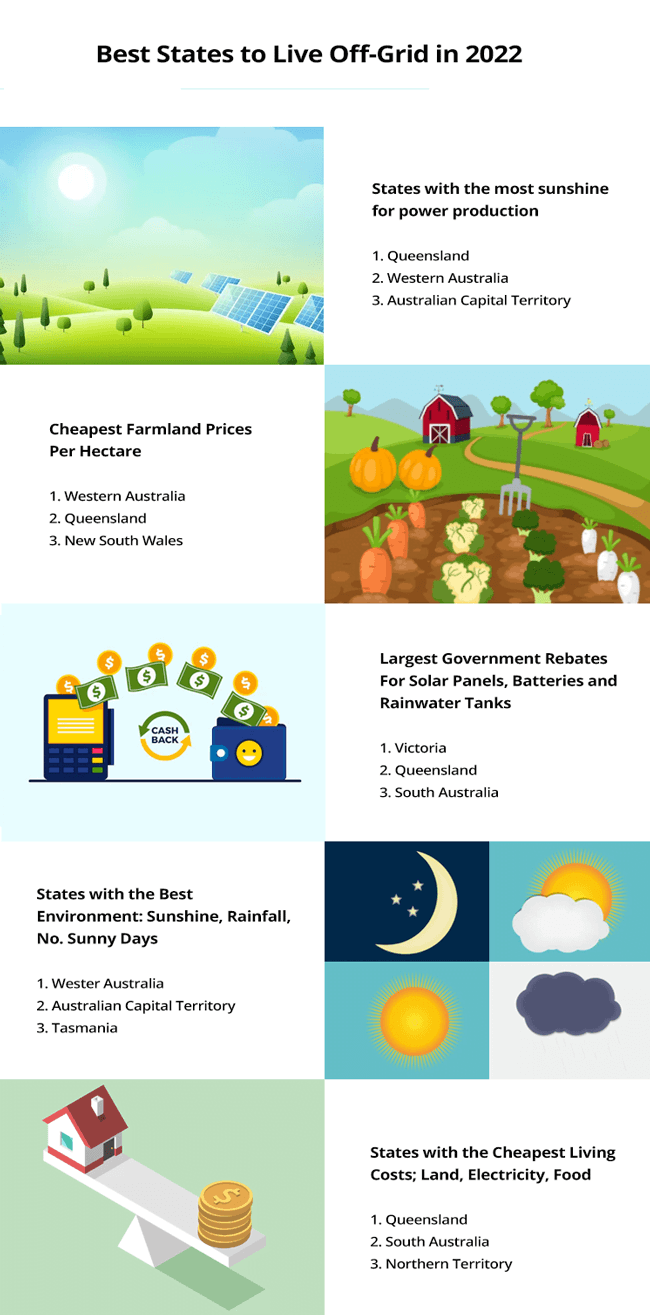
Table of Contents
ToggleState ranking
In the following table, each state stands in their overall ranking order.
| Overall rank | State | Total score | Cost rank | Energy Rebate | Eco rank | Feasibility rank | Safety rank |
|---|---|---|---|---|---|---|---|
| 1 | Queensland | 190 | 40 | 54 | 43 | 29 | 24 |
| 2 | Victoria | 176 | 21 | 57 | 34 | 23 | 41 |
| 3 | Australian Capital Territory | 170 | 24 | 51 | 48 | 5 | 42 |
| 4 | Western Australia | 169 | 25 | 36 | 53 | 26 | 29 |
| 5 | South Australia | 157 | 26 | 54 | 31 | 20 | 26 |
| 6 | Northern territory | 156 | 25 | 48 | 42 | 24 | 17 |
| 7 | New South Wales | 155 | 23 | 42 | 37 | 19 | 34 |
| 8 | Tasmania | 135 | 17 | 24 | 45 | 20 | 29 |
The category-based ranking is represented graphically with variable scores.
In the most basic terms, going off the grid can mean living in suburbia and just producing your own power. The cost of solar panels, batteries, and the government incentives will be one of the only metrics you are looking at.
Below we have broken down the winning states by metric into 4 main categories which include power generation, cost of land and living, Environment/ feasibility, and hazards.
See full study results here
| Catagory | Possible Variables | Description | Impact over off grid living | Data source | Specific concerns with off grid living | |
| 1 | Cost | Cost of land | What is the average cost of the land of the particular state and if there is any daviation in the zoning based price. | High | https://www.ruralbank.com.au/ | If one has to finance the land and the building of the home, he/she will need a construction home loan, which is a lot like a traditional mortgage, except it’s for building the home and comes with some more stringent rules. Moreover, if one thinking about farming and raising cattle, it creates more land demand |
| 2 | Cost | Average cost of Electricity | The average cost people need to pay for living in the major cities of the particular state | Medium | https://www.aemc.gov.au/sites/default/files/2020-12/AEMC%20National%20summary%20Infographic%20FINAL.pdf | More expensive electricity costs would increase the incentive for going off-grid for the city dwellers. |
| 4 | Cost | Living cost | Cost of living indexes include expenses such as food, shelter, transportation, energy, clothing, healthcare, and childcare. A cost of living index is also used to track how much the costs of basic expenses rise over a period. | Low | ||
| 5 | Energy and water incentive | Current rebates for solar installlation | The solar panel rebate is an Australian government initiative called the Small-scale Renewable Energy Scheme. If you install an eligible solar power system, you will receive a rebate by claiming the Small-scale Technology Certificates (STCs). | High | Please see tab "Rebates & System Prices by State" on this sheet | More rebates for solar power will potentially reduce the cost of setting the power source to satisfy the energy demand and promote a sustainable power source. |
| 6 | Energy and water incentive | Rebates for solar batteries | The Australian Capital Territory government is also offering a rebate on the purchase of new solar batteries. The rebate can save you up to $825 per kWh off the cost of a battery. | High | This battery rebate will further downsize the cost of power source installation and maintenance cost in future. | |
| 7 | Energy and water incentive | "Renewable power incentives (Rebates)" | Households and small businesses across Australia that install a small scale renewable energy system (solar, wind or hydro) or eligible hot water system may be able to receive a benefit under the Small-scale Renewable Energy Scheme (SRES) to help with the purchase cost. | High | https://www.energy.gov.au/rebates/renewable-power-incentives | |
| 8 | Energy and water incentive | Rainwater rebate | Help from the government in setting up rainwater system | Medium | https://www.energy.gov.au/rebates/rainwater-tank-rebate | Definately a big plus for australians who wants to live off-grid. The Water Corporation Rainwater tank rebate provides eligible Western Australian customers, including residential and non-residential properties, schools, not-for-profit property and government owned property, with rebates of up to $1000 to install or replace a rainwater tank. |
| 9 | Environment | Daily sunshine hours | Sunshine duration or sunshine hours is a climatological indicator, measuring duration of sunshine in given period (usually, a day or a year) for a given location on Earth, typically expressed as an averaged value over several years. | High | http://www.bom.gov.au/watl/sunshine/ | The more hours of sunshine the more energy that can be captured.In the best-case scenario, solar panels to receive about four or five hours of direct sunlight. Specifically, that sunlight should reach your panels between 10 am and 3 pm. This is when the sun is in its highest position and the rays are the most direct |
| 10 | Environment | Rainfall | A measure of the intensity of rainfall by calculating the amount of rain that would fall over a given interval of time if the rainfall intensity were constant over that time period. The rate is typically expressed in terms of length (depth) per unit time, for example, millimeters per hour, or inches per hour. | High | https://www.statista.com/statistics/610486/australia-rainfall-by-state/ | The balance between growing your food (rain = good) and powering your home with solar (rain = bad). Furthermore, rain in a place away from the city hydro system will act as a source of clean water for daily uses (rain=good). |
| 11 | Environment | No. of Sunny Days (no clouds) | Number of days in a year it usually stays sunny | Medium | https://www.currentresults.com/Weather/Australia/Cities/sunshine-annual-average.php | Ties into the above rainfall stats. High rainfall but lots of sunny days would be ideal. This variable canbe easily pair up with the rainfall variable. |
| 12 | Environment | Tempreture range | Measures the average range of temperature in a specific time of the year | Medium | https://en.wikipedia.org/wiki/Climate_of_Australia | Hursh winter or summer requires more preparation and resource for living. These can impact economically also discourage the occupant to stay in the place |
| 13 | Environment | Wind speed | Average wind velosity of the are in different season | High | After solar, the wind is considered a widespread energy source for living off-grid. Wind can be utilized to produce extra energy and store it when solar is not generating enough power to satisfy the energy need. | |
| 14 | Feasiblity | Growing crops | Growing own food in the aquired land | Medium | Soil fertility and natural conditions that foster crop growth is always a plus for promoting self dependency while living away from the conventional market system | |
| 15 | Feasiblity | Natural resoirces (forest, waters etc.) | Low | |||
| 16 | Feasiblity | Population density | Density of people living in the rural sattlements | Low | ||
| 17 | Hazard | Flooding threat | Historical data about food frequency and flood levels for the area | Medium | https://en.wikipedia.org/wiki/Floods_in_Australia | Frequently flood-affected places should be avoided. Otherwise, there is a strong chance of facing flood-related troubles often. |
| 18 | Emergency services | There is sometimes emergency (health, fire hazard, natural/ man-made disasters etc.) that could appear and require emergency assistance from external service providers. number of hospitals and fire station for unit of people | Historical data about food frequency and flood levels for the area | Low | If the area specifically has a history of natural disasters, it's always good to check for a location with good community support and access to emergency services. | |
| 19 | Hazard | Weather issues/ Diseaster Index | Stability of the weather and chances of happening extreme weather events. The Disaster Risk Index (DRI) is aimed at assessing the average risk of death per country in large and medium-scale disasters associated with earthquakes, tropical cyclones, and floods. | High | https://www.preventionweb.net/files/72869_sodrrpublicationready07082019.pdf | How frequent and any chances of extreme weather events in that area will reduce the feasibility of selecting the place for long-term off-grid living. |
| 20 | Hazard | Violance/crime rate | The rate of crime in the particular state both in cities and outside of cities | Medium | https://www.abs.gov.au/statistics/people/crime-and-justice/recorded-crime-victims/latest-release#northern-territory | The crime rate of a state, if data available for both cities and outside of the cities of that state, will represent facts about safety considerations while living outside the city surveillanc system2. |
| Catagory | Possible Variables | Weight | Max value | Min value | Best | |
| 1 | Cost | Cost of land | 3 | 10930 | 2569 | Min |
| 2 | Cost | Average cost of Electricity (c/kWh) | 2 | 38.96 | 22.2 | Min |
| 3 | Cost | Zoning and property tax | ||||
| 4 | Cost | living cost (average monthly cost) | 1 | 3650 | 2600 | Min |
| 5 | Energy and water incentive | Current rebates for solar installlation (rebate for e 6 kWh system) | 3 | 3157 | 2733 | Max |
| 6 | Energy and water incentive | "Renewable power incentives (Rebates)" | 3 | 3157 | 2733 | Max |
| 7 | Energy and water incentive | Rainwater rebate | 3 | 3157 | 2733 | Max |
| 8 | Environment | Daily sunshine hours | 3 | 3157 | 2733 | Max |
| 9 | Environment | Rainfall | 3 | 3157 | 2733 | Max |
| 10 | Environment | No. of Sunny Days (no clouds) | 3 | 3157 | 2733 | Max |
| 11 | Environment | Tempreture range | 3 | 3157 | 2733 | Max |
| 12 | Environment | Wind speed | 3 | 3157 | 2733 | Max |
| 13 | Feasiblity | Growing crops | 3 | 3157 | 2733 | Max |
| 14 | Feasiblity | Natural resoirces (forest, waters etc.) | 3 | 3157 | 2733 | Max |
| 15 | Feasiblity | Population density | 3 | 3157 | 2733 | Max |
| 16 | Hazard | Flooding threat | 3 | 3157 | 2733 | Max |
| 17 | Emergency services | There is sometimes emergency (health, fire hazard, natural/ man-made disasters etc.) that could appear and require emergency assistance from external service providers. number of hospitals and fire station for unit of people | 3 | 3157 | 2733 | Max |
| 18 | Hazard | Weather issues/ Diseaster Index | 3 | 3157 | 2733 | Max |
| 19 | Hazard | Violance/crime rate | 3 | 3157 | 2733 | Max |
| Catagory | Possible Variables | Weight | Max value | Min value | Best | |
| 1 | Australian Capital Territory | 22.81 | 7 | 2 | 14 | Min |
| 2 | New South Wales | 26.53 | 4 | 2 | 8 | Min |
| 3 | Northern Territory | 24.23 | 6 | 2 | 12 | Min |
| 4 | South Australia | 35.32 | 8 | 4 | 16 | Min |
| 5 | Tasmania | 26.59 | 3 | 2 | 6 | Min |
| 6 | Western Australia | 38.96 | 1 | 2 | 2 | Min |
| States | Growth from last year (%) | Average 5 year annual growth(%) | Average price of per hectare land | Rank | Weight | Total value | Best | |
| 1 | Western Australia | 28.2 | 7.2 | 2569 | 7 | 3 | 21 | min |
| 2 | Queensland | 15.7 | 4.9 | 4650 | 6 | 3 | 18 | min |
| 3 | South Australia | 18.4 | 10.5 | 4943 | 5 | 3 | 15 | min |
| 4 | South Australia | 35.32 | 8 | 4 | 16 | Min | ||
| 5 | New South Wales | 17.2 | 11.1 | 5066 | 4 | 3 | 12 | Min |
| 6 | Australian Capital Territory | 5907 | 3 | 3 | 9 | Min | ||
| 7 | Northern territory | 5907 | 3 | 3 | 9 | Min | ||
| 8 | Victoria | 12.1 | 9.1 | 7587 | 2 | 3 | 6 | Min |
| 9 | Tasmania | 11.1 | 7.2 | 10930 | 1 | 3 | 3 | Min |
| Catagory | Possible Variables | Description | Impact over off grid living | Data source | Specific concerns with off grid living | |
| 1 | Cost | Cost of land | What is the average cost of the land of the particular state and if there is any daviation in the zoning based price. | High | https://www.ruralbank.com.au/ | If one has to finance the land and the building of the home, he/she will need a construction home loan, which is a lot like a traditional mortgage, except it’s for building the home and comes with some more stringent rules. Moreover, if one thinking about farming and raising cattle, it creates more land demand |
| 2 | Cost | Average cost of Electricity | The average cost people need to pay for living in the major cities of the particular state | Medium | https://www.aemc.gov.au/sites/default/files/2020-12/AEMC%20National%20summary%20Infographic%20FINAL.pdf | More expensive electricity costs would increase the incentive for going off-grid for the city dwellers. |
| 4 | Cost | Living cost | Cost of living indexes include expenses such as food, shelter, transportation, energy, clothing, healthcare, and childcare. A cost of living index is also used to track how much the costs of basic expenses rise over a period. | Low | ||
| 5 | Energy and water incentive | Current rebates for solar installlation | The solar panel rebate is an Australian government initiative called the Small-scale Renewable Energy Scheme. If you install an eligible solar power system, you will receive a rebate by claiming the Small-scale Technology Certificates (STCs). | High | Please see tab "Rebates & System Prices by State" on this sheet | More rebates for solar power will potentially reduce the cost of setting the power source to satisfy the energy demand and promote a sustainable power source. |
| 6 | Energy and water incentive | Rebates for solar batteries | The Australian Capital Territory government is also offering a rebate on the purchase of new solar batteries. The rebate can save you up to $825 per kWh off the cost of a battery. | High | This battery rebate will further downsize the cost of power source installation and maintenance cost in future. | |
| 7 | Energy and water incentive | "Renewable power incentives (Rebates)" | Households and small businesses across Australia that install a small scale renewable energy system (solar, wind or hydro) or eligible hot water system may be able to receive a benefit under the Small-scale Renewable Energy Scheme (SRES) to help with the purchase cost. | High | https://www.energy.gov.au/rebates/renewable-power-incentives | |
| 8 | Energy and water incentive | Rainwater rebate | Help from the government in setting up rainwater system | Medium | https://www.energy.gov.au/rebates/rainwater-tank-rebate | Definately a big plus for australians who wants to live off-grid. The Water Corporation Rainwater tank rebate provides eligible Western Australian customers, including residential and non-residential properties, schools, not-for-profit property and government owned property, with rebates of up to $1000 to install or replace a rainwater tank. |
| 9 | Environment | Daily sunshine hours | Sunshine duration or sunshine hours is a climatological indicator, measuring duration of sunshine in given period (usually, a day or a year) for a given location on Earth, typically expressed as an averaged value over several years. | High | http://www.bom.gov.au/watl/sunshine/ | The more hours of sunshine the more energy that can be captured.In the best-case scenario, solar panels to receive about four or five hours of direct sunlight. Specifically, that sunlight should reach your panels between 10 am and 3 pm. This is when the sun is in its highest position and the rays are the most direct |
| 10 | Environment | Rainfall | A measure of the intensity of rainfall by calculating the amount of rain that would fall over a given interval of time if the rainfall intensity were constant over that time period. The rate is typically expressed in terms of length (depth) per unit time, for example, millimeters per hour, or inches per hour. | High | https://www.statista.com/statistics/610486/australia-rainfall-by-state/ | The balance between growing your food (rain = good) and powering your home with solar (rain = bad). Furthermore, rain in a place away from the city hydro system will act as a source of clean water for daily uses (rain=good). |
| 11 | Environment | No. of Sunny Days (no clouds) | Number of days in a year it usually stays sunny | Medium | https://www.currentresults.com/Weather/Australia/Cities/sunshine-annual-average.php | Ties into the above rainfall stats. High rainfall but lots of sunny days would be ideal. This variable canbe easily pair up with the rainfall variable. |
| 12 | Environment | Tempreture range | Measures the average range of temperature in a specific time of the year | Medium | https://en.wikipedia.org/wiki/Climate_of_Australia | Hursh winter or summer requires more preparation and resource for living. These can impact economically also discourage the occupant to stay in the place |
| 13 | Environment | Wind speed | Average wind velosity of the are in different season | High | After solar, the wind is considered a widespread energy source for living off-grid. Wind can be utilized to produce extra energy and store it when solar is not generating enough power to satisfy the energy need. | |
| 14 | Feasiblity | Growing crops | Growing own food in the aquired land | Medium | Soil fertility and natural conditions that foster crop growth is always a plus for promoting self dependency while living away from the conventional market system | |
| 15 | Feasiblity | Natural resoirces (forest, waters etc.) | Low | |||
| 16 | Feasiblity | Population density | Density of people living in the rural sattlements | Low | ||
| 17 | Hazard | Flooding threat | Historical data about food frequency and flood levels for the area | Medium | https://en.wikipedia.org/wiki/Floods_in_Australia | Frequently flood-affected places should be avoided. Otherwise, there is a strong chance of facing flood-related troubles often. |
| 18 | Emergency services | There is sometimes emergency (health, fire hazard, natural/ man-made disasters etc.) that could appear and require emergency assistance from external service providers. number of hospitals and fire station for unit of people | Historical data about food frequency and flood levels for the area | Low | If the area specifically has a history of natural disasters, it's always good to check for a location with good community support and access to emergency services. | |
| 19 | Hazard | Weather issues/ Diseaster Index | Stability of the weather and chances of happening extreme weather events. The Disaster Risk Index (DRI) is aimed at assessing the average risk of death per country in large and medium-scale disasters associated with earthquakes, tropical cyclones, and floods. | High | https://www.preventionweb.net/files/72869_sodrrpublicationready07082019.pdf | How frequent and any chances of extreme weather events in that area will reduce the feasibility of selecting the place for long-term off-grid living. |
| 20 | Hazard | Violance/crime rate | The rate of crime in the particular state both in cities and outside of cities | Medium | https://www.abs.gov.au/statistics/people/crime-and-justice/recorded-crime-victims/latest-release#northern-territory | The crime rate of a state, if data available for both cities and outside of the cities of that state, will represent facts about safety considerations while living outside the city surveillanc system2. |
| Zone | 1 | 2 | 3 |
| Rating | 1.622 | 1.536 | 1.382 |
| STC Price | $38.50 |
| KW | 1.5 | 2 | 3 | 4 | 5 | 6 | 6.6 | 7 | 8 | 9 | 10 | 12 | 15 |
| # STC's | 21 | 29 | 43 | 58 | 72 | 87 | 96 | 102 | 116 | 131 | 145 | 175 | 218 |
| Gross Cost | $3,836 | $4,423 | $5,411 | $6,685 | $7,920 | $9,342 | $9,886 | $10,540 | $11,740 | $12,895 | $14,012 | $18,288 | $20,500 |
| Rebate Amount | $809 | $1,117 | $1,656 | $2,233 | $2,772 | $3,350 | $3,696 | $3,927 | $4,466 | $5,044 | $5,583 | $6,738 | $8,393 |
| Net Cost | $3,028 | $3,307 | $3,756 | $4,452 | $5,148 | $5,993 | $6,190 | $6,613 | $7,274 | $7,852 | $8,430 | $11,551 | $12,107 |
| Cost per Watt | 2.02 | 1.65 | 1.25 | 1.11 | 1.03 | 1.00 | 0.94 | 0.94 | 0.91 | 0.87 | 0.84 | 0.96 | 0.81 |
| KW | 1.5 | 2 | 3 | 4 | 5 | 6 | 6.6 | 7 | 8 | 9 | 10 | 12 | 15 |
| # STC's | 20 | 27 | 41 | 55 | 69 | 82 | 91 | 96 | 110 | 124 | 138 | 165 | 207 |
| Gross Cost | $3,836 | $4,423 | $5,411 | $6,685 | $7,920 | $9,342 | $9,886 | $10,540 | $11,740 | $12,895 | $14,012 | $18,288 | $20,500 |
| Rebate Amount | $770 | $1,040 | $1,579 | $2,118 | $2,657 | $3,157 | $3,504 | $3,696 | $4,235 | $4,774 | $5,313 | $6,353 | $7,970 |
| Net Cost | $3,066 | $3,384 | $3,833 | $4,568 | $5,264 | $6,185 | $6,383 | $6,844 | $7,505 | $8,121 | $8,699 | $11,936 | $12,531 |
| KW | 1.5 | 2 | 3 | 4 | 5 | 6 | 6.6 | 7 | 8 | 9 | 10 | 12 | 15 |
| # STC's | 18 | 24 | 37 | 49 | 62 | 74 | 82 | 87 | 99 | 111 | 124 | 149 | 186 |
| Gross Cost | $3,836 | $4,423 | $5,411 | $6,685 | $7,920 | $9,342 | $9,886 | $10,540 | $11,740 | $12,895 | $14,012 | $18,288 | $20,500 |
| Rebate Amount | $693 | $924 | $1,425 | $1,887 | $2,387 | $2,849 | $3,157 | $3,350 | $3,812 | $4,274 | $4,774 | $5,737 | $7,161 |
| Net Cost | $3,143 | $3,499 | $3,987 | $4,799 | $5,533 | $6,493 | $6,729 | $7,191 | $7,929 | $8,622 | $9,238 | $12,552 | $13,339 |
| KW | 1.5 | 2 | 3 | 4 | 5 | 6 | 6.6 | 7 | 8 | 9 | 10 | 12 | 15 |
| # STC's | 17 | 21 | 31 | 42 | 53 | 62 | 70 | 74 | 85 | 95 | 106 | 127 | 159 |
| Gross Cost | $3,836 | $4,423 | $5,411 | $6,685 | $7,920 | $9,342 | $9,886 | $10,540 | $11,740 | $12,895 | $14,012 | $18,288 | $20,500 |
| Rebate Amount | $655 | $809 | $1,194 | $1,617 | $2,041 | $2,387 | $2,695 | $2,849 | $3,273 | $3,658 | $4,081 | $4,890 | $6,122 |
| Net Cost | $3,182 | $3,615 | $4,218 | $5,068 | $5,880 | $6,955 | $7,191 | $7,691 | $8,468 | $9,238 | $9,931 | $13,399 | $14,379 |
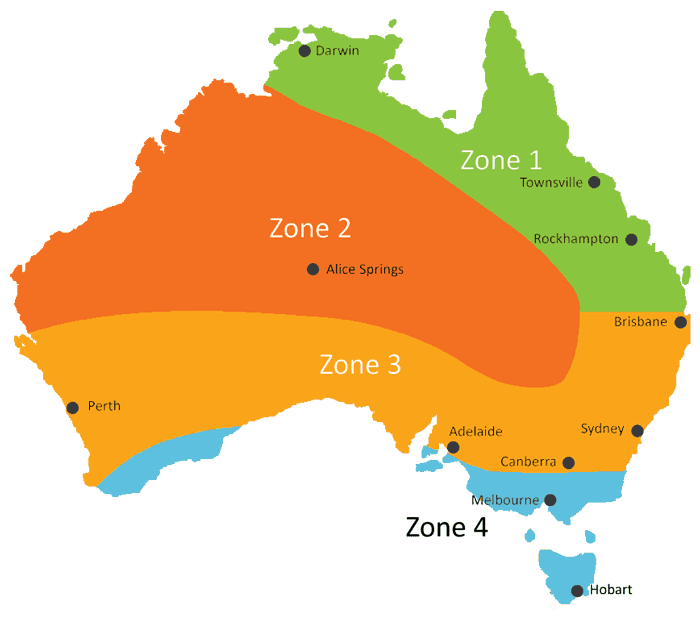
| Zone | Rating |
| 1 | 1.622 |
| 2 | 1.536 |
| 3 | 1.382 |
| 5 | 1.185 |
| Catagory | Possible Variables | Weight | Max value | Min value | Best | |
| 1 | Australian Capital Territory | 22.81 | 7 | 2 | 14 | Min |
| 2 | New South Wales | 26.53 | 4 | 2 | 8 | Min |
| 3 | Northern Territory | 24.23 | 6 | 2 | 12 | Min |
| 4 | South Australia | 35.32 | 8 | 4 | 16 | Min |
| 5 | Tasmania | 26.59 | 3 | 2 | 6 | Min |
| 6 | Western Australia | 38.96 | 1 | 2 | 2 | Min |
| States | Growth from last year (%) | Average 5 year annual growth(%) | Average price of per hectare land | Rank | Weight | Total value | Best | |
| 1 | Western Australia | 28.2 | 7.2 | 2569 | 7 | 3 | 21 | min |
| 2 | Queensland | 15.7 | 4.9 | 4650 | 6 | 3 | 18 | min |
| 3 | South Australia | 18.4 | 10.5 | 4943 | 5 | 3 | 15 | min |
| 4 | South Australia | 35.32 | 8 | 4 | 16 | Min | ||
| 5 | New South Wales | 17.2 | 11.1 | 5066 | 4 | 3 | 12 | Min |
| 6 | Australian Capital Territory | 5907 | 3 | 3 | 9 | Min | ||
| 7 | Northern territory | 5907 | 3 | 3 | 9 | Min | ||
| 8 | Victoria | 12.1 | 9.1 | 7587 | 2 | 3 | 6 | Min |
| 9 | Tasmania | 11.1 | 7.2 | 10930 | 1 | 3 | 3 | Min |
| Catagory | Possible Variables | Description | Impact over off grid living | Data source | Specific concerns with off grid living | |
| 1 | Cost | Cost of land | What is the average cost of the land of the particular state and if there is any daviation in the zoning based price. | High | https://www.ruralbank.com.au/ | If one has to finance the land and the building of the home, he/she will need a construction home loan, which is a lot like a traditional mortgage, except it’s for building the home and comes with some more stringent rules. Moreover, if one thinking about farming and raising cattle, it creates more land demand |
| 2 | Cost | Average cost of Electricity | The average cost people need to pay for living in the major cities of the particular state | Medium | https://www.aemc.gov.au/sites/default/files/2020-12/AEMC%20National%20summary%20Infographic%20FINAL.pdf | More expensive electricity costs would increase the incentive for going off-grid for the city dwellers. |
| 4 | Cost | Living cost | Cost of living indexes include expenses such as food, shelter, transportation, energy, clothing, healthcare, and childcare. A cost of living index is also used to track how much the costs of basic expenses rise over a period. | Low | ||
| 5 | Energy and water incentive | Current rebates for solar installlation | The solar panel rebate is an Australian government initiative called the Small-scale Renewable Energy Scheme. If you install an eligible solar power system, you will receive a rebate by claiming the Small-scale Technology Certificates (STCs). | High | Please see tab "Rebates & System Prices by State" on this sheet | More rebates for solar power will potentially reduce the cost of setting the power source to satisfy the energy demand and promote a sustainable power source. |
| 6 | Energy and water incentive | Rebates for solar batteries | The Australian Capital Territory government is also offering a rebate on the purchase of new solar batteries. The rebate can save you up to $825 per kWh off the cost of a battery. | High | This battery rebate will further downsize the cost of power source installation and maintenance cost in future. | |
| 7 | Energy and water incentive | "Renewable power incentives (Rebates)" | Households and small businesses across Australia that install a small scale renewable energy system (solar, wind or hydro) or eligible hot water system may be able to receive a benefit under the Small-scale Renewable Energy Scheme (SRES) to help with the purchase cost. | High | https://www.energy.gov.au/rebates/renewable-power-incentives | |
| 8 | Energy and water incentive | Rainwater rebate | Help from the government in setting up rainwater system | Medium | https://www.energy.gov.au/rebates/rainwater-tank-rebate | Definately a big plus for australians who wants to live off-grid. The Water Corporation Rainwater tank rebate provides eligible Western Australian customers, including residential and non-residential properties, schools, not-for-profit property and government owned property, with rebates of up to $1000 to install or replace a rainwater tank. |
| 9 | Environment | Daily sunshine hours | Sunshine duration or sunshine hours is a climatological indicator, measuring duration of sunshine in given period (usually, a day or a year) for a given location on Earth, typically expressed as an averaged value over several years. | High | http://www.bom.gov.au/watl/sunshine/ | The more hours of sunshine the more energy that can be captured.In the best-case scenario, solar panels to receive about four or five hours of direct sunlight. Specifically, that sunlight should reach your panels between 10 am and 3 pm. This is when the sun is in its highest position and the rays are the most direct |
| 10 | Environment | Rainfall | A measure of the intensity of rainfall by calculating the amount of rain that would fall over a given interval of time if the rainfall intensity were constant over that time period. The rate is typically expressed in terms of length (depth) per unit time, for example, millimeters per hour, or inches per hour. | High | https://www.statista.com/statistics/610486/australia-rainfall-by-state/ | The balance between growing your food (rain = good) and powering your home with solar (rain = bad). Furthermore, rain in a place away from the city hydro system will act as a source of clean water for daily uses (rain=good). |
| 11 | Environment | No. of Sunny Days (no clouds) | Number of days in a year it usually stays sunny | Medium | https://www.currentresults.com/Weather/Australia/Cities/sunshine-annual-average.php | Ties into the above rainfall stats. High rainfall but lots of sunny days would be ideal. This variable canbe easily pair up with the rainfall variable. |
| 12 | Environment | Tempreture range | Measures the average range of temperature in a specific time of the year | Medium | https://en.wikipedia.org/wiki/Climate_of_Australia | Hursh winter or summer requires more preparation and resource for living. These can impact economically also discourage the occupant to stay in the place |
| 13 | Environment | Wind speed | Average wind velosity of the are in different season | High | After solar, the wind is considered a widespread energy source for living off-grid. Wind can be utilized to produce extra energy and store it when solar is not generating enough power to satisfy the energy need. | |
| 14 | Feasiblity | Growing crops | Growing own food in the aquired land | Medium | Soil fertility and natural conditions that foster crop growth is always a plus for promoting self dependency while living away from the conventional market system | |
| 15 | Feasiblity | Natural resoirces (forest, waters etc.) | Low | |||
| 16 | Feasiblity | Population density | Density of people living in the rural sattlements | Low | ||
| 17 | Hazard | Flooding threat | Historical data about food frequency and flood levels for the area | Medium | https://en.wikipedia.org/wiki/Floods_in_Australia | Frequently flood-affected places should be avoided. Otherwise, there is a strong chance of facing flood-related troubles often. |
| 18 | Emergency services | There is sometimes emergency (health, fire hazard, natural/ man-made disasters etc.) that could appear and require emergency assistance from external service providers. number of hospitals and fire station for unit of people | Historical data about food frequency and flood levels for the area | Low | If the area specifically has a history of natural disasters, it's always good to check for a location with good community support and access to emergency services. | |
| 19 | Hazard | Weather issues/ Diseaster Index | Stability of the weather and chances of happening extreme weather events. The Disaster Risk Index (DRI) is aimed at assessing the average risk of death per country in large and medium-scale disasters associated with earthquakes, tropical cyclones, and floods. | High | https://www.preventionweb.net/files/72869_sodrrpublicationready07082019.pdf | How frequent and any chances of extreme weather events in that area will reduce the feasibility of selecting the place for long-term off-grid living. |
| 20 | Hazard | Violance/crime rate | The rate of crime in the particular state both in cities and outside of cities | Medium | https://www.abs.gov.au/statistics/people/crime-and-justice/recorded-crime-victims/latest-release#northern-territory | The crime rate of a state, if data available for both cities and outside of the cities of that state, will represent facts about safety considerations while living outside the city surveillanc system2. |
| Catagory | Possible Variables | Weight | Max value | Min value | Best | |
| 1 | Cost | Cost of land | 3 | 10930 | 2569 | Min |
| 2 | Cost | Average cost of Electricity (c/kWh) | 2 | 38.96 | 22.2 | Min |
| 3 | Cost | Zoning and property tax | ||||
| 4 | Cost | living cost (average monthly cost) | 1 | 3650 | 2600 | Min |
| 5 | Energy and water incentive | Current rebates for solar installlation (rebate for e 6 kWh system) | 3 | 3157 | 2733 | Max |
| 6 | Energy and water incentive | "Renewable power incentives (Rebates)" | 3 | 3157 | 2733 | Max |
| 7 | Energy and water incentive | Rainwater rebate | 3 | 3157 | 2733 | Max |
| 8 | Environment | Daily sunshine hours | 3 | 3157 | 2733 | Max |
| 9 | Environment | Rainfall | 3 | 3157 | 2733 | Max |
| 10 | Environment | No. of Sunny Days (no clouds) | 3 | 3157 | 2733 | Max |
| 11 | Environment | Tempreture range | 3 | 3157 | 2733 | Max |
| 12 | Environment | Wind speed | 3 | 3157 | 2733 | Max |
| 13 | Feasiblity | Growing crops | 3 | 3157 | 2733 | Max |
| 14 | Feasiblity | Natural resoirces (forest, waters etc.) | 3 | 3157 | 2733 | Max |
| 15 | Feasiblity | Population density | 3 | 3157 | 2733 | Max |
| 16 | Hazard | Flooding threat | 3 | 3157 | 2733 | Max |
| 17 | Emergency services | There is sometimes emergency (health, fire hazard, natural/ man-made disasters etc.) that could appear and require emergency assistance from external service providers. number of hospitals and fire station for unit of people | 3 | 3157 | 2733 | Max |
| 18 | Hazard | Weather issues/ Diseaster Index | 3 | 3157 | 2733 | Max |
| 19 | Hazard | Violance/crime rate | 3 | 3157 | 2733 | Max |
| Catagory | Possible Variables | Weight | Max value | Min value | Best | |
| 1 | Australian Capital Territory | 22.81 | 7 | 2 | 14 | Min |
| 2 | New South Wales | 26.53 | 4 | 2 | 8 | Min |
| 3 | Northern Territory | 24.23 | 6 | 2 | 12 | Min |
| 4 | South Australia | 35.32 | 8 | 4 | 16 | Min |
| 5 | Tasmania | 26.59 | 3 | 2 | 6 | Min |
| 6 | Western Australia | 38.96 | 1 | 2 | 2 | Min |
| States | Growth from last year (%) | Average 5 year annual growth(%) | Average price of per hectare land | Rank | Weight | Total value | Best | |
| 1 | Western Australia | 28.2 | 7.2 | 2569 | 7 | 3 | 21 | min |
| 2 | Queensland | 15.7 | 4.9 | 4650 | 6 | 3 | 18 | min |
| 3 | South Australia | 18.4 | 10.5 | 4943 | 5 | 3 | 15 | min |
| 4 | South Australia | 35.32 | 8 | 4 | 16 | Min | ||
| 5 | New South Wales | 17.2 | 11.1 | 5066 | 4 | 3 | 12 | Min |
| 6 | Australian Capital Territory | 5907 | 3 | 3 | 9 | Min | ||
| 7 | Northern territory | 5907 | 3 | 3 | 9 | Min | ||
| 8 | Victoria | 12.1 | 9.1 | 7587 | 2 | 3 | 6 | Min |
| 9 | Tasmania | 11.1 | 7.2 | 10930 | 1 | 3 | 3 | Min |
Energy and water Incentives
This part of the study looked at the best government incentives for solar panels, battery storage, and rainwater tanks. The amount of government assistance in each state for getting set up with power and water was very important in this study. Other than purchasing a property, installing solar panels and a water tank are the next biggest expenses. Victoria and Tasmania were clear winners here. Although their solar rebates were slightly lower than other states, they had very generous water tank rebates which tipped them over the edge.
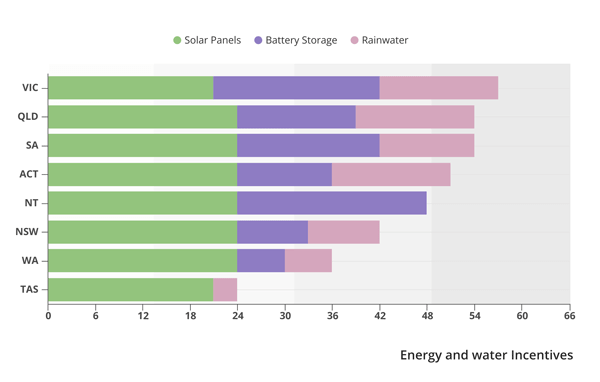
Set up and living costs
If you are looking to start over and want to purchase land, we took into account the cost per acre, ongoing living cost, and average cost of electricity in that area. All three will give us a good insight into the overall living costs of a state. Everyone’s idea of going off-grid is different. Some just see it as going off the electrical grid and still living in the suburbs, while others really lean into it by growing their own food, collecting rainwater, and being fully self-sufficient.

Environmental factors
This part of the study looks at environmental factors which could make or break you including the number of sunshine hours for generating power, temperature range, and average rainfall for growing crops. We wanted to be thorough and cater the study towards those looking to go full-tilt with their off-grid adventure.
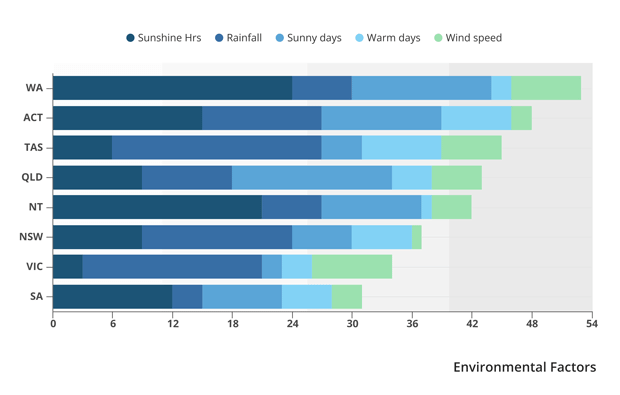
Feasibility
Feasibility rank takes the state’s potential of growing crops, the portion of natural resources ( e.g. forest, water bodies), and privacy (e.g. population density). Queensland held the top position in our feasibility rank and found the Australian capital territory less feasible.

Hazard Safety
Some states are more prone to natural disasters such as regular flooding and animal/ insect plagues while others are simply unlivable during the height of summer. We also took into account emergency services and crime rates.

Methodology and metrics
We ranked 6 Australian states and 2 Territories based on 5 categories consisting of 18 variables. We weighted the variables between 1 to 3 where 1 indicates low, and 3 is premier in influence on the off-grid living. Based on the variable value, we classified the states in order and multiplied them with the weight to get the score for a state/territory.
| Category | Variables | Weight | Max value | Min value | Best |
|---|---|---|---|---|---|
| Cost | Cost of land (per hectare) | 3 | 10930 | 2569 | Min |
| The average cost of Electricity (c/kWh) | 2 | 38.96 | 22.2 | Min | |
| Zoning and property tax | |||||
| living cost (average monthly cost) | 1 | 3650 | 2600 | Min | |
| Energy and water incentive | Current rebates for solar installation (rebate for e 6 kWh system) | 3 | 3157 | 2733 | Max |
| Rebates for solar batteries ( incentive as rebate and loans) | 3 | 6000 | 0 | Max | |
| Renewable power incentives (Rebates) | |||||
| Rainwater rebate | 3 | 1000 | 220 | Max | |
| Environment | Sunshine hours (annual sunshine hours) | 3 | 3212 | 2037 | Max |
| Rainfall (in mm) | 3 | 1295.2 | 222.2 | Max | |
| No. of Sunny Days (#of sunny days in a year) | 3 | 272 | 185 | Max | |
| Warm days ( # of days <35 C in a year) | 1 | 67 | 2 | Min | |
| wind speed (average yearly wind speed MPH) | 1 | 12.7 | 6.95 | Max | |
| Feasibility | Growing crops (% of total crop production) | 2 | 26% | 1% | Max |
| Natural resources (% of forest) | 1 | 65% | 9% | Max | |
| Population density (# of person per sq km) | 2 | 0.18 | 171 | Min | |
| Hazard safety | Flooding threat (# of major recorded flood from 1806) | 2 | 12 | 2 | Min |
| Emergency services (# of hospital per 1000 person) | 1 | 20.72 | 0.98 | Max | |
| Weather issues/ Disaster Index (% of land in low resilience zone) | 2 | 37% | 99.40% | Min | |
| Security against violence/crime (Offenders per 100,000) | 2 | 3848 | 648 | Min |
Supports for off-grid living in Australia
Interest and attention on off-grid living are on the rise in Australia. Even though living off-grid is recognized as a simpler way of living, the steps of getting out of a gridded lifestyle to settling down away from modern networks are always a challenge. Luckily Australia has communities and helping groups to alleviate the challenges of your transition, saving your experience from being wretched.
Off-grid communities
Aldinga Arts EcoVillage (AAEV) Focuses on permaculture, environmental sustainability, and arts. Being a cohesive community, AAEV considers people as their most valuable resource. The community offers tons of group activities and small projects.
Witchcliffe Ecovillage (WEV) is a new initiative in Western Australia which took 10 years of planning and proved to be very affordable. WEV focuses on reducing the carbon footprint of the daily activity of settlers. Furthermore, WEV arranges regular workshops on managing waste, food harvesting, and reducing carbon footprint.
Energy
GoSolarQuotes is working on the thrust of achieving self-sufficiency and renewability in the energy sector. In the competitive solar energy market, GoSolarQuotes facilitate education and enable the matching of prices from different contractors for your project.
Housing
Tiny Homes Foundation (THF) is committed to providing environmentally, socially, and economically sustainable housing solutions. Tiny Homes Foundation is a not-for-profit organization dedicated to providing socially, ecologically, and financially sustainable affordable housing solutions. THF aims to provide priority housing to people who are at risk of homelessness and provide housing support and services to disadvantaged youths.
Farming
FB group
WWOOFers provides volunteering opportunities for organic farmers to understand the culture, educate people about growing crops and promote sustainability in agriculture.
Off-Grid Living: Prepping to Live Off the Grid is a vibrant group with 169.0 k off-grid enthusiastic people worldwide. This Facebook group is an excellent way of connecting with same-minded people who constantly share their experiences, challenges, and sorting out.
Table of Contents
Toggle


